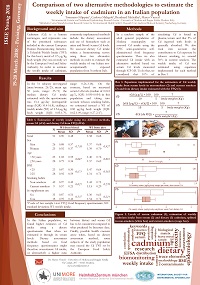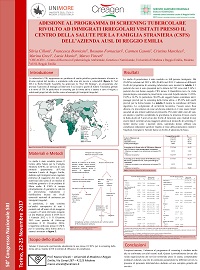Filippini T, Michalke B, Wise LA, Malagoli C, Malavolti M, Vescovi L, Salvia C, Bargellini A, Sieri S, Krogh V, Ferrante M, Vinceti M. Food Chem Toxicol. 2018 May;115:482-490. PMID: 29621579 – DOI: 10.1016/j.fct.2018.03.048 Abstract Selenium is a trace element of both nutritional
Original article: Riluzole and other prognostic factors in ALS: a population-based registry study in Italy
Mandrioli J, Malerba SA, Beghi E, Fini N, Fasano A, Zucchi E, De Pasqua S, Guidi C, Terlizzi E, Sette E, Ravasio A, Casmiro M, Salvi F, Liguori R, Zinno L, Handouk Y, Rizzi R, Borghi A, Rinaldi R, Medici D, Santangelo M, Granieri E, Mussuto V, Aiello M, Ferro S, Vinceti M; ERRALS Group.
J Neurol. 2018 Feb 5. doi: 10.1007/s00415-018-8778-y.
Abstract
OBJECTIVE: In this prospective population-based registry study on ALS survival, we investigated the role of riluzole treatment, together with other clinical factors, on the prognosis in incident ALS cases in Emilia Romagna Region (ERR), Italy.
METHODS: A registry for ALS has been collecting all incident cases in ERR since 2009. Detailed clinical data from all patients diagnosed with ALS between 1.1.2009 and 31.12.2014 have been analyzed for this study, with last follow up date set at 31.12.2015.
RESULTS: During the 6 years of the study, there were 681 incident cases with a median tracheostomy-free survival of 40 months (95% CI 36-44) from onset and of 26 months (95% CI 24-30) from diagnosis; 573 patients (84.14%) were treated with riluzole, 207 (30.39%) patients underwent gastrostomy, 246 (36.12%) non invasive ventilation, and 103 (15.15%) invasive ventilation. Patients who took treatment for ≥ 75% of disease duration from diagnosis had a median survival of 29 months compared to 18 months in patients with < 75% treatment duration. In multivariable analysis, factors independently influencing survival were age at onset (HR 1.04, 95% CI 1.02-1.05, p < 0.001), dementia (HR 1.56, 95% CI 1.05-2.32, p = 0.027), degree of diagnostic certainty (HR 0.88, 95% CI 0.78-0.98, p = 0.021), gastrostomy (HR 1.46, 95% CI 1.14-1.88, p = 0.003), NIV (HR 1.43, 95% CI 1.12-1.82, p = 0.004), and weight loss at diagnosis (HR 1.05, 95% CI 1.03-1.07, p < 0.001), diagnostic delay (HR 0.98, 95% CI 0.97-0.99, p = 0.004), and % treatment duration (HR 0.98, 95% CI 0.98-0.99, p < 0.001).
CONCLUSIONS: Independently from other prognostic factors, patients who received riluzole for a longer period of time survived longer, but further population based studies are needed to verify if long-tem use of riluzole prolongs survival.
KEYWORDS: Amyotrophic lateral sclerosis; Prognostic factors; Riluzole; Survival; Therapeutic intervention
Original article: Cadmium and atherosclerosis: A review of toxicological mechanisms and a meta-analysis of epidemiologic studies
Tinkov AA, Filippini T, Ajsuvakova OP, Skalnaya MG, Aaseth J, Bjørklund G, Gatiatulina ER, Popova EV, Nemereshina ON, Huang PT, Vinceti M, Skalny AV.
Environ Res. 2018 Jan 19;162:240-260. doi: 10.1016/j.envres.2018.01.008
Abstract
Cadmium has been proposed to be the one of the factors of atherosclerosis development, although the existing data are still controversial. The primary objective of the present study is the review and the meta-analysis of studies demonstrating the association between Cd exposure and atherosclerosis as well as review of the potential mechanisms of such association. We performed a systematic search in the PubMed-Medline database using the MeSH terms cadmium, cardiovascular disease, atherosclerosis, coronary artery disease, myocardial infarction, stroke, mortality and humans up through December 20, 2017. Elevated urinary Cd levels were associated with increased mortality for cardiovascular disease (HR = 1.34, 95% CI: 1.07-1.67) as well as elevated blood Cd levels (HR = 1.78, 95% CI: 1.24-2.56). Analysis restricted to never smokers showed similar, though more imprecise, results. Consistently, we also observed an association between Cd exposure markers (blood and urine) and coronary heart disease, stroke, and peripheral artery disease. Moreover, Cd exposure was associated with atherogenic changes in lipid profile. High Cd exposure was associated with higher TC levels (OR = 1.48, 95% CI: 1.10-2.01), higher LDL-C levels (OR = 1.31, 95% CI 0.99-1.73) and lower HDL-C levels (OR = 1.96, 95% CI: 1.09-3.55). The mechanisms of atherogenic effect of cadmium may involve oxidative stress, inflammation, endothelial dysfunction, enhanced lipid synthesis, up-regulation of adhesion molecules, prostanoid dysbalance, as well as altered glycosaminoglycan synthesis.
Poster: Risk of amyotrophic lateral sclerosis and passive residential exposure to pesticides: comparison of questionnaire-based with GIS-based exposure assessment methods
Amyotrophic lateral sclerosis (ALS) is a progressive neurodegenerative disease with still unknown aetiology. Among environmental factors, pesticides have been investigated due to their potential neurotoxic effects. Within a population-based case-control study conducted in two Italian regions, we aimed to investigate ALS risk due to passive residential exposure to pesticides using two methodologies. Methods
Poster: Comparison of two alternative methodologies to estimate the weekly intake of cadmium in an italian population
Cadmium (Cd) is a human carcinogen. In non-smoking and non-occupationally exposed subjects diet is the main source of exposure. The Tolerable Weekly Intake-TWI of 2.5 µg/kg body weight has been recently set by the European Food and Safety Authority in order to guarantee a high protection to general population. In this study, we aimed to compare two different methods to estimate its weekly intake.
Original article: Selenium for preventing cancer (Review)
Vinceti M, Filippini T, Del Giovane C, Dennert G, Zwahlen M, Brinkman M, Zeegers MPA, Horneber M, D’Amico R, Crespi CM
Cochrane Database of Systematic Reviews 2018, Issue 1. Art. No.: CD005195. doi: 10.1002/14651858.CD005195.pub4
Abstract
Review q…
Original article: Air dispersion modelling for the evaluation of population exposure to pollutants emitted by complex areal sources
Costanzini S, Teggi S, Bigi A, Ghermandi G, Filippini T, Malagoli C, Nannini R, Vinceti M.
Atmosphere. 2018;9(2):38 doi: 10.3390/atmos9020038
Abstract
This work originates from an epidemiological study aimed to assess the correlation between population exposure to pesticides used in agriculture and adverse health effects. In support of the population exposure evaluation two models implemented by the authors were applied: a GIS-based proximity model and the CAREA atmospheric dispersion model. In this work, the results of the two models are presented and compared. Despite the proximity analysis is widely used for these kinds of studies, it was investigated how meteorology could affect the exposure assessment. Both models were applied to pesticides emitted by 1519 agricultural fields and considering 2584 receptors distributed over an area of 8430 km2. CAREA output shows a considerable enhancement in the percentage of exposed receptors, from the 4% of the proximity model to the 54% of the CAREA model. Moreover, the spatial analysis of the results on a specific test site showed that the effects of meteorology considered by CAREA led to an anisotropic exposure distribution that differs considerably from the symmetric distribution resulting by the proximity model. In addition, the results of a field campaign for the definition and planning of ground measurement of concentration for the validation of CAREA are presented. The preliminary results showed how, during treatments, pesticide concentrations distant from the fields are significantly higher than background values.
Original article: A selenium species in cerebrospinal fluid predicts conversion to Alzheimer’s dementia in persons with mild cognitive impairment
Vinceti M, Chiari A, Eichmüller M, Rothman KJ, Filippini T, Malagoli C, Weuve J, Tondelli M, Zamboni G, Nichelli PF, Michalke B.
Alzheimers Res Ther. 2017; 9:100. doi: 10.1186/s13195-017-0323-1
Abstract
Background: Little is known about factors influencing progression from mild cognitive impairment to Alzheimer’s dementia. A potential role of environmental chemicals and specifically of selenium, a trace element of nutritional and toxicological relevance, has been suggested. Epidemiologic studies of selenium are lacking, however, with the exception of a recent randomized trial based on an organic selenium form.
Methods: We determined concentrations of selenium species in cerebrospinal fluid sampled at diagnosis in 56 participants with mild cognitive impairment of nonvascular origin. We then investigated the relation of these concentrations to subsequent conversion from mild cognitive impairment to Alzheimer’s dementia.
Results: Twenty-one out of the 56 subjects developed Alzheimer’s dementia during a median follow-up of 42 months; four subjects developed frontotemporal dementia and two patients Lewy body dementia. In a Cox proportional hazards model adjusting for age, sex, duration of sample storage, and education, an inorganic selenium form, selenate, showed a strong association with Alzheimer’s dementia risk, with an adjusted hazard ratio of 3.1 (95% confidence interval 1.0–9.5) in subjects having a cerebrospinal fluid content above the median level, compared with those with lower concentration. The hazard ratio of Alzheimer’s dementia showed little departure from unity for all other inorganic and organic selenium species. These associations were similar in analyses that measured exposure on a continuous scale, and also after excluding individuals who converted to Alzheimer’s dementia at the beginning of the follow-up.
Conclusions: These results indicate that higher amounts of a potentially toxic inorganic selenium form in cerebrospinal fluid may predict conversion from mild cognitive impairment to Alzheimer’s dementia.
Poster: Adesione al programma di screening tubercolare rivolto ad immigrati irregolari visitati presso il Centro della Salute per la Famiglia Straniera (CSFS) dell’Azienda AUSL di Reggio Emilia
La tubercolosi (TB) rappresenta un problema di sanità pubblica particolarmente rilevante in diverse regioni del mondo, e soprattutto nelle aree più povere e vulnerabili. Nel 2014 la World Health Assembly ha tra l’altro approvato la ‘End TB Strategy’, un programma che prevede l’adozione di strategie ed interventi il cui scopo è quello di ridurre l’incidenza globale e le morti di TB. In particolare lo screening per la forma attiva e latente si deve rivolgere a selezionati gruppi ad alto rischio come ad esempio gli immigrati irregolari.
Poster: Epidemiologia della forma attiva e latente di tubercolosi in un gruppo di immigrati irregolari visitati presso il Centro della Salute per la Famiglia Straniera (CSFS) dell’Azienda AUSL di Reggio Emilia
La tubercolosi (TB) continua ad essere un importante problema di sanità pubblica a livello mondiale: nel 2015 sono stati stimati 10,4 milioni di nuovi casi e 1,8 milioni di decessi. Gli immigrati irregolari rappresentano una sottopopolazione con un’elevata prevalenza di tubercolosi in forma attiva e latente; è quindi importante individuarne le caratteristiche al fine di riconoscere eventuali gruppi ad alto rischio ed indirizzare più efficacemente interventi sanitari e risorse.




